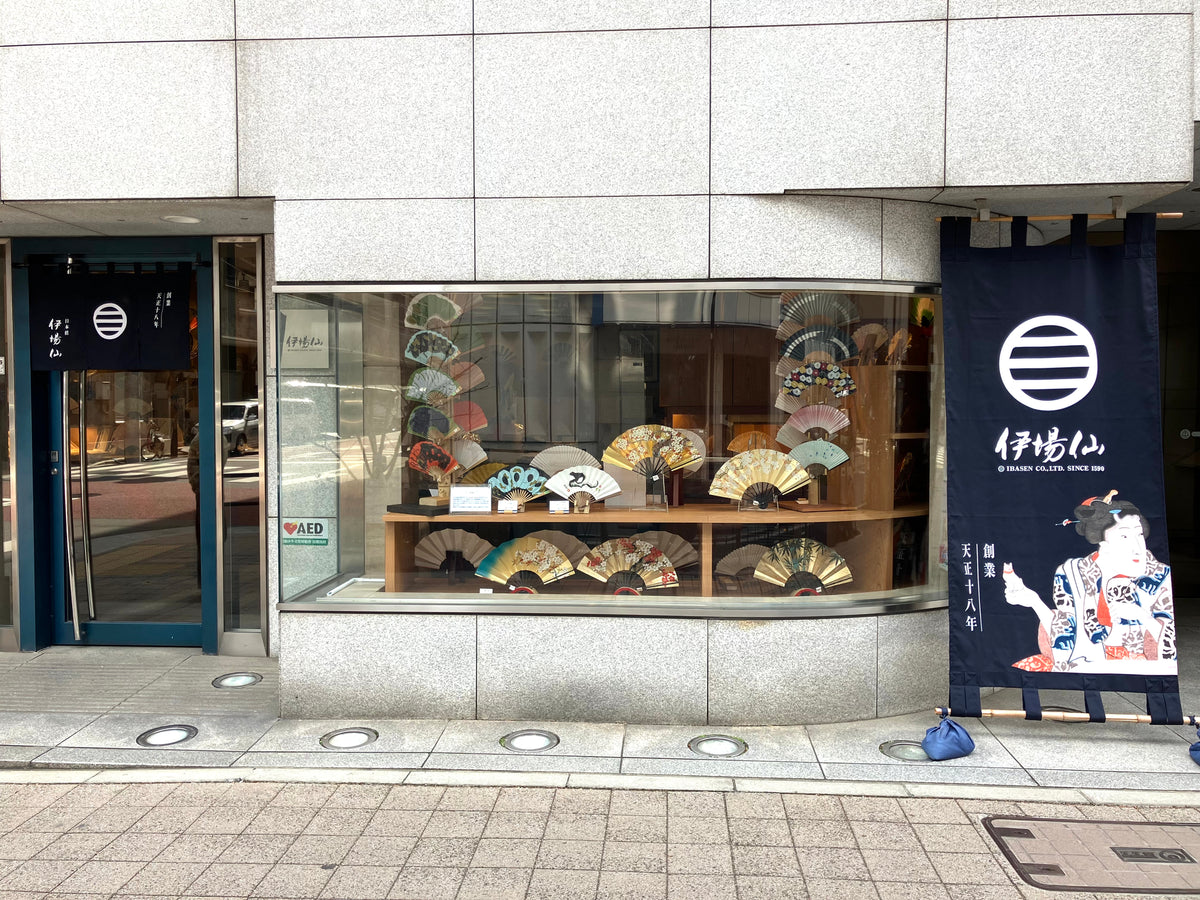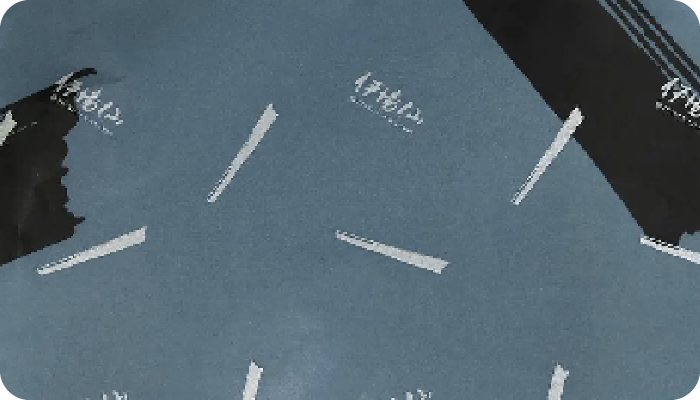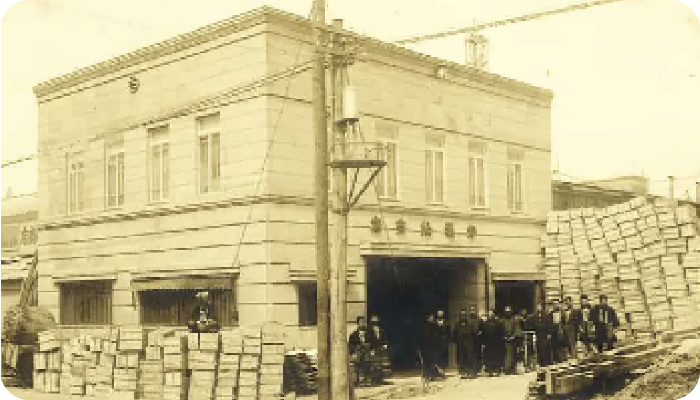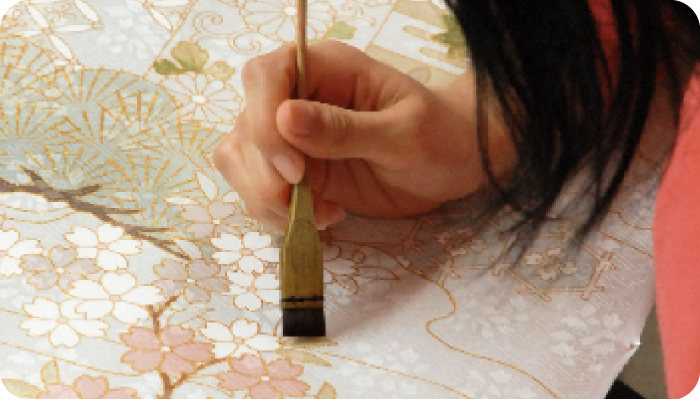folding fanMain types of|Classification by material, use, place of origin, size, and correct usage
Used in a wide range of situations from daily life to lessons and celebrationsfolding fanIt is used in a wide range of situations from daily life to lessons and celebrations. Suchfolding fanare many different types. In recent years, in addition to using them yourself, they have been given as gifts and souvenirs tofolding fanas gifts, so we would like to check how to choose the right one for you. In this article,folding fanThis article explains the different types of materials, uses, production areas, sizes, and patterns (designs) that you should keep in mind when purchasing What kind offolding fanPlease read this article for reference if you are at a loss as to what type to choose.

By Materialfolding fanMain types of
folding fanThere are differences in appearance and feel depending on the materials used for each part of the particularfolding fanto choose the right one for you, we have listed the following by material.folding fanThe following is a brief description of the different types of
Paperfolding fan(paper)
paperfolding fanis a paper used for the fan surface.folding fanThe method is to make a fan by inserting a fan bone into three sheets of pasted together base paper. A common type offolding fanThere are a wide variety of variations due to the It is easy to choose your favorite pattern, design, and size. There are also products using Japanese paper for the fan surface.
Fabricfolding fan(Kiji Sensu)
Doughfolding fanis "clothfolding fanalso called "cloth", is a transparent fabric used on the fan surface.folding fanThe cloth used for the fan surface is of various types, including silk and polyester. There are various types of cloth used for the fan surface, including silk and polyester. Paperfolding fanis made by attaching the fabric to only one side of the fan bone, so that one side of the fan bone is exposed, unlike [1]
Sandalwoodfolding fan(sandalwood fan)
Made from sandalwoodfolding fanSandalwood, also called sandalwood, is a plant native to India. Sandalwood, also called sandalwood, is a plant native to India, and its fragrance comes from the wood itself. It is also famous as a material for incense sticks and has a sweet and gentle odor. Sandalwoodfolding fanis not only enjoyable for its fragrance, but also for the openwork carving on the fan surface of the wood. [2]
Japanese cypress fan
Hinoki fans are made by binding thin cypress boards with silk threads and fastening them with a kaname (keystone).folding fanThe hinoki fan was born in the Heian period (794-1185) when paper was precious. It was born in the Heian period (794-1185) when paper was precious and was used at court. Many modern hinoki fans are also high-end products with gorgeous maki-e decorations on the fan surface and string ornaments. They are also popular as indoor decorations for gift-giving purposes.folding fanThey are also popular as interior decorations for gifts. [3]
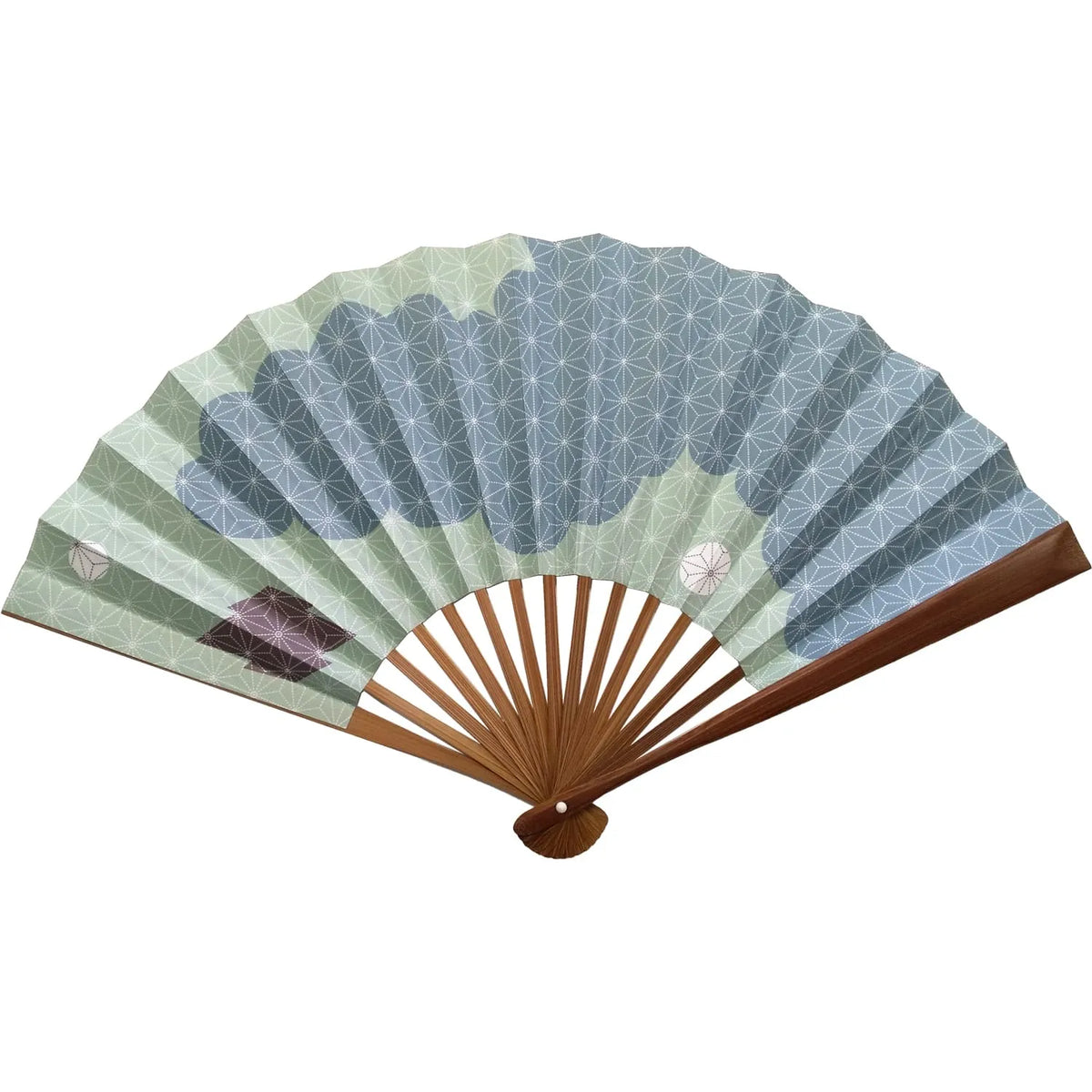
Paperfolding fan
Edo fan
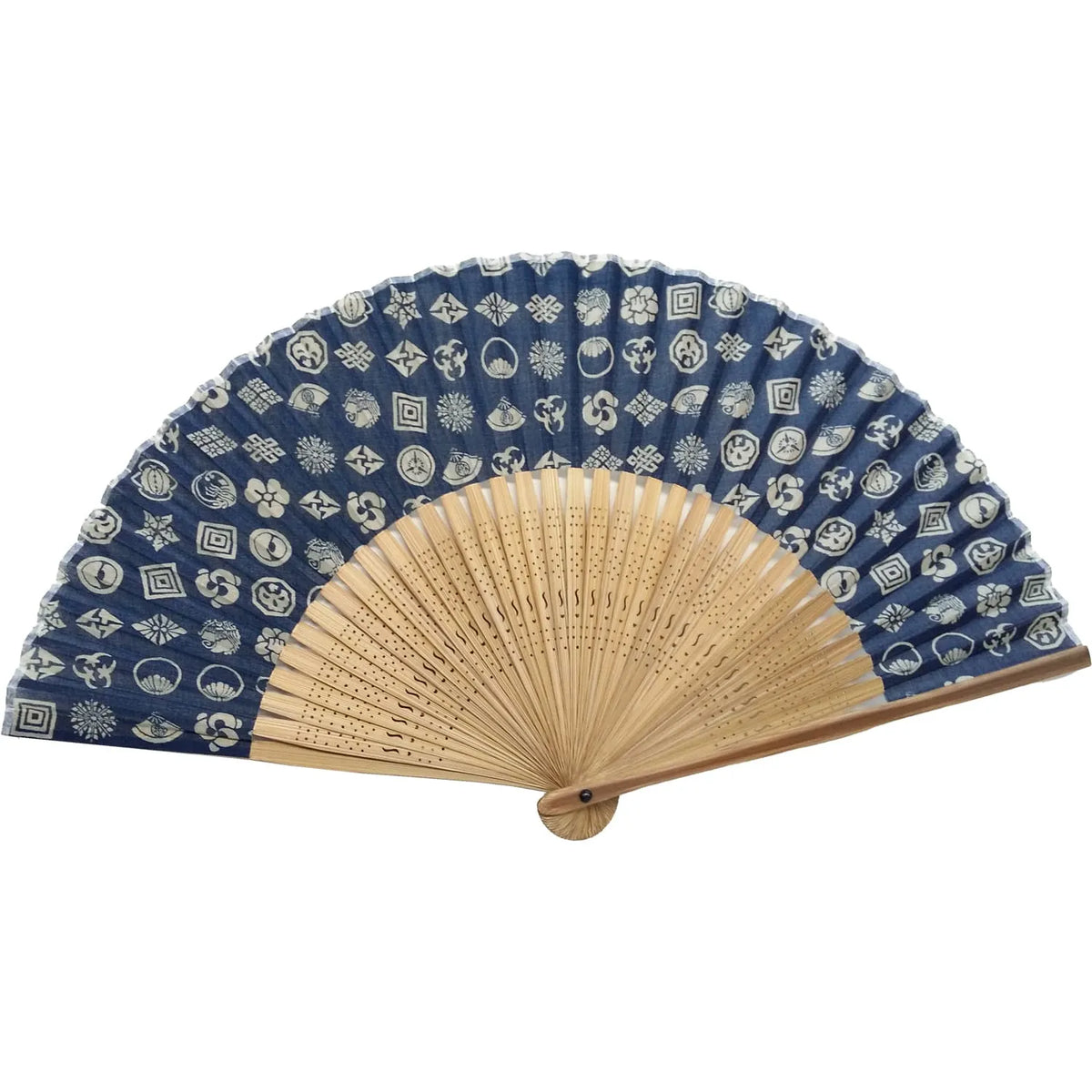
Fabricfolding fan
Tenugui Hand Towelfolding fan
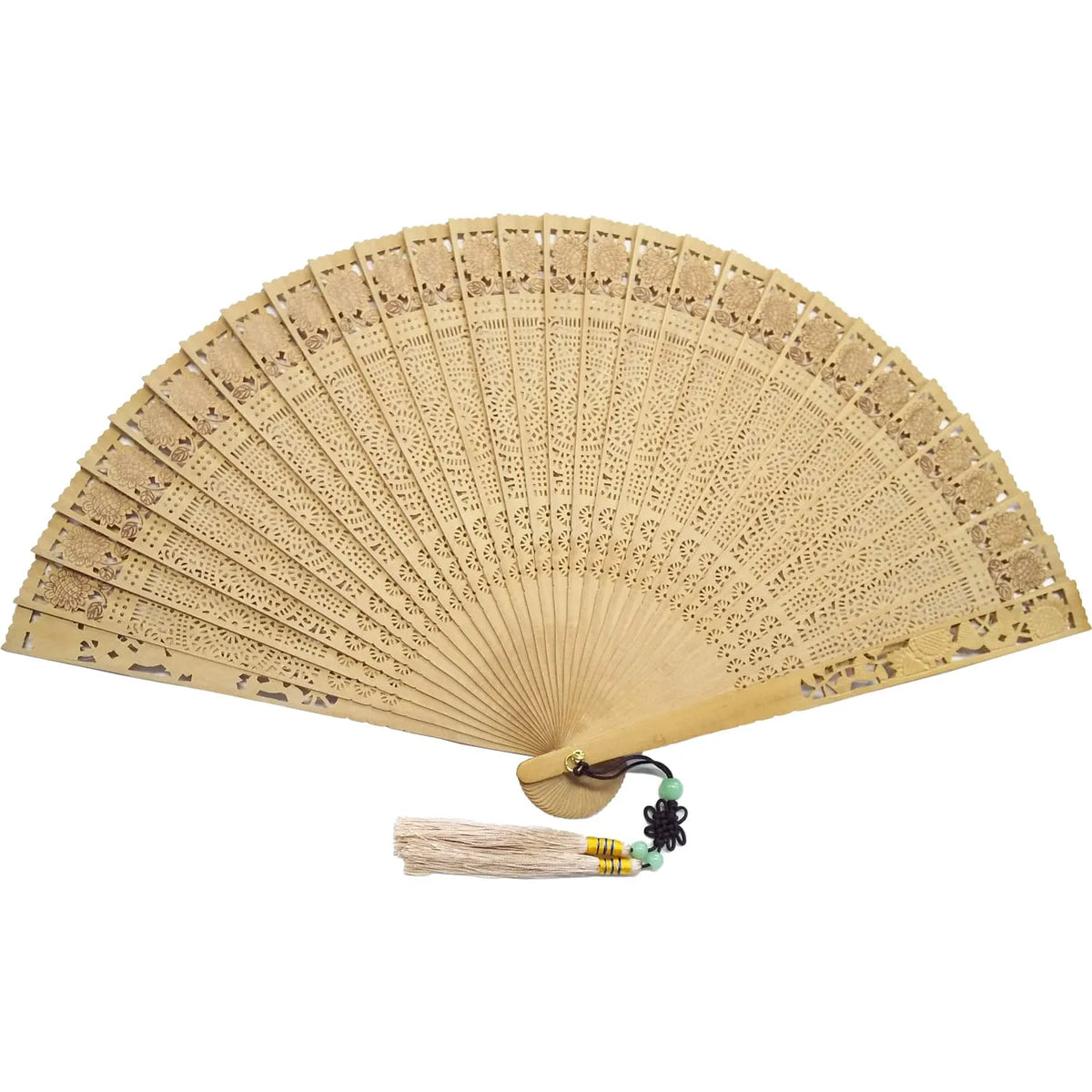
Sandalwoodfolding fan
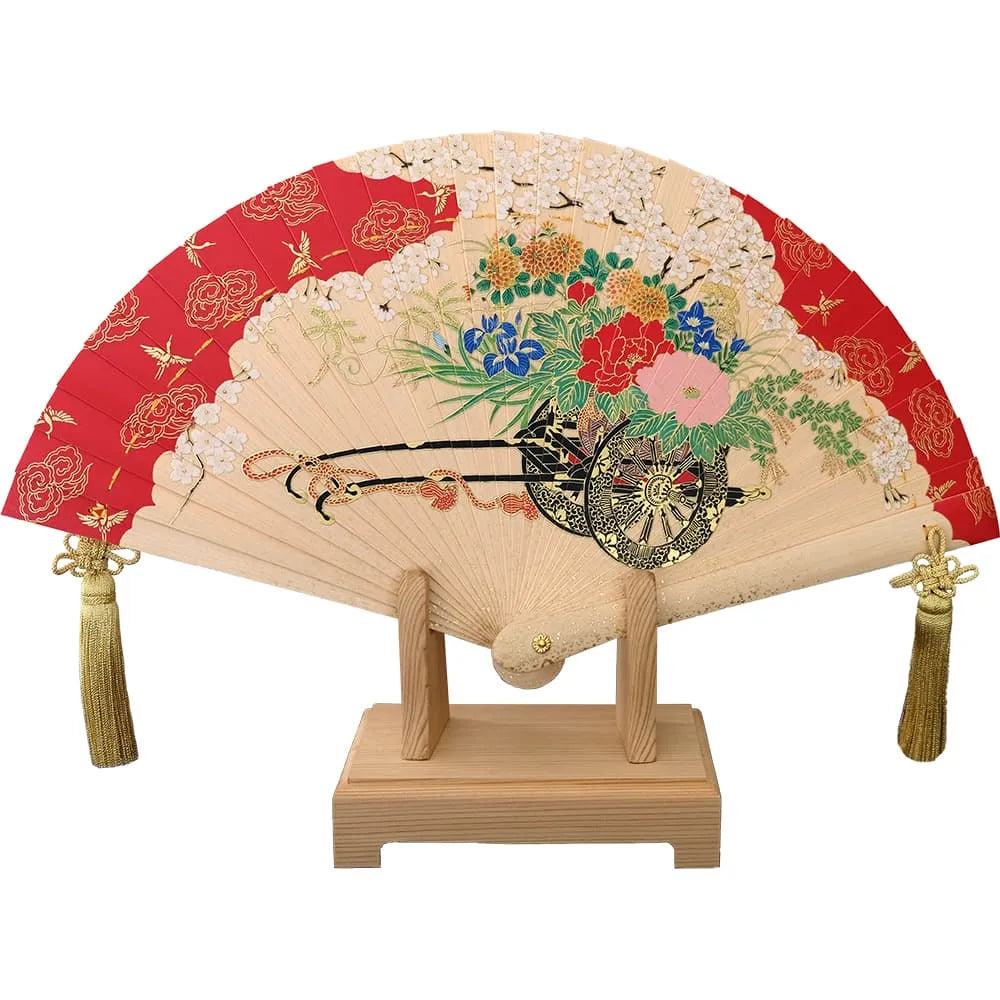
Japanese cypress fan
By Purposefolding fanMain types of
Multiple according to season and scenefolding fanmay be used in different ways. Here,folding fanare introduced here by purpose.
summerfolding fan(Summer Senzu)
Paper used in summerfolding fanand clothfolding fanused in summer is called summerfolding fanis called Summerfolding fanis characterized by the use of fans to cool off. Generallyfolding fanreferred to as "summerfolding fanis often used to refer to the summer season. In addition, paperfolding fanis called Natsu-ogi (summer fan), while hinoki fans made of wood are sometimes called Fuyu-ogi (winter fan).
Decorationfolding fan(kazari-senzu)
decorationfolding fanis used to decorate homes, stores, etc. as indoor decorations.folding fanIt is used to decorate homes, shops, etc. as indoor decorations.folding fanIt is decorated by standing it up in an open position in the Summerfolding fanIt is not used with a fan as in the case of Decorationfolding fans fans are decorated with seasonal designs and lucky charms, and are often used in gift-giving situations. [4]
Dancefolding fan(Mai-sen-sus)
Mai (dance)folding fanis used in Japanese dance and other dances.folding fanIt is also called a mai ogi (dance fan). It is also called a mai ogi (dance fan). It is often decorated with gorgeous gold and silver designs to make it look glamorous on stage, and both sides are decorated with the same patterns. Generalfolding fanMai has a sturdier structure, with thicker bones, etc., thanfolding fanand some dances have a sturdier structure, with thicker bones, etc., than the standard dances. [5]
Shimai-fan (shimai-sen, shimai-o-gi)
A shimai fan is a fan used in the traditional Japanese performing arts of Noh and Kyogen.folding fanIt is used in the traditional Japanese performing arts of Noh and Kyogen. The size, color, and pattern of the shimai-fan varies depending on the role played on stage and the school of Noh. [6]
Shugi sen (congratulatory fan)
Shugi-sen is a fan used in the ceremonial dress of kimono.folding fanused in the ceremonial dress of kimono.folding fanis considered a lucky charm because of its shape of the end of a fan, and is used as a small accessory at prestigious celebrations such as weddings. A congratulatory fan generally has a black lacquered parent bone and a gold or silver fan face. [7]
Teafolding fan(Cha-sen-su, cha-ou-gi)
Teafolding fanis used in the tea ceremony at tea ceremonies.folding fanIt is It is used as a prop to convey courtesy, including greetings at tea ceremonies, and has an important meaning. Teafolding fanis a common summerfolding fanIt is smaller in size than the tea ceremonyfolding fanis used in a closed position. [8]
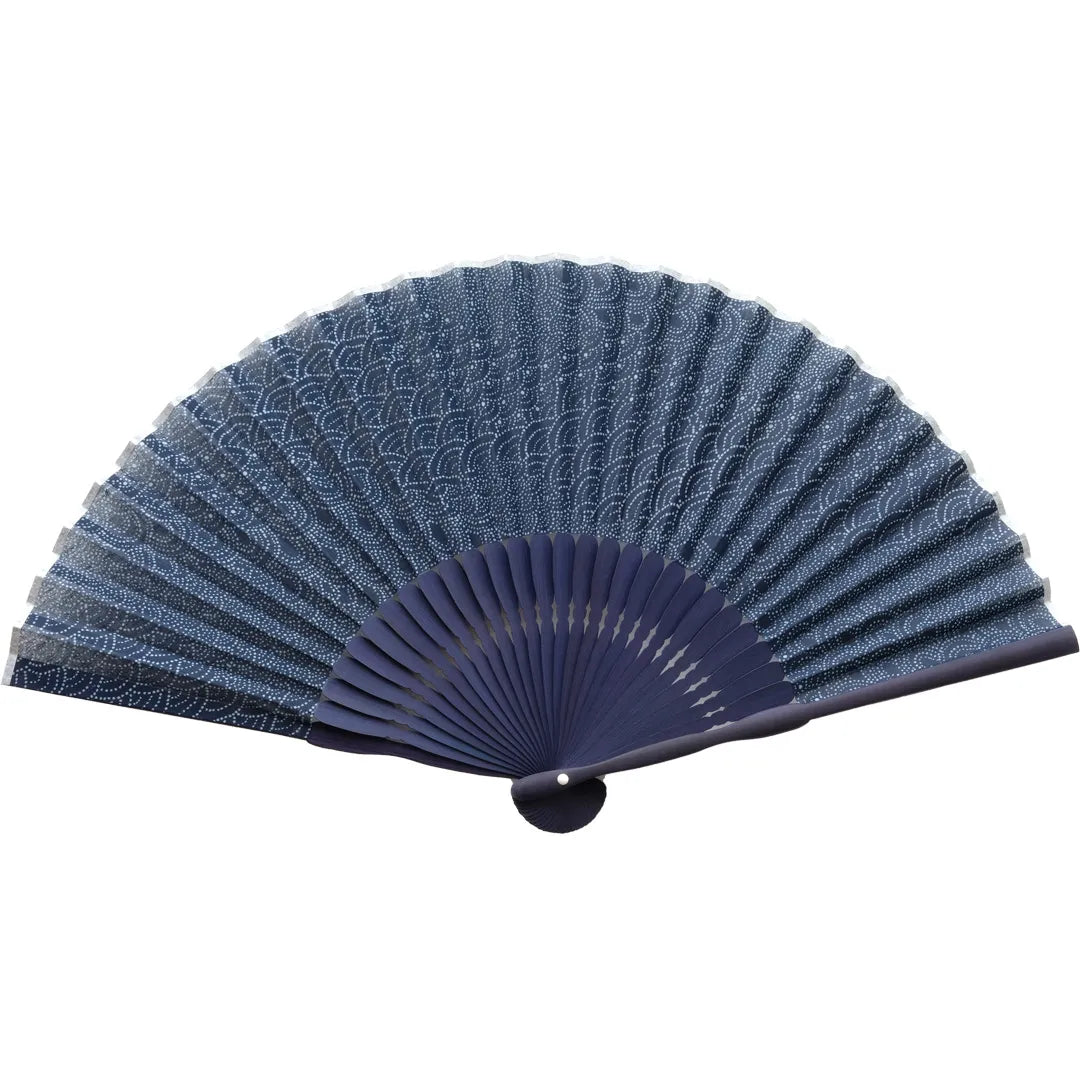
Summerfolding fan
indigo dyefolding fan
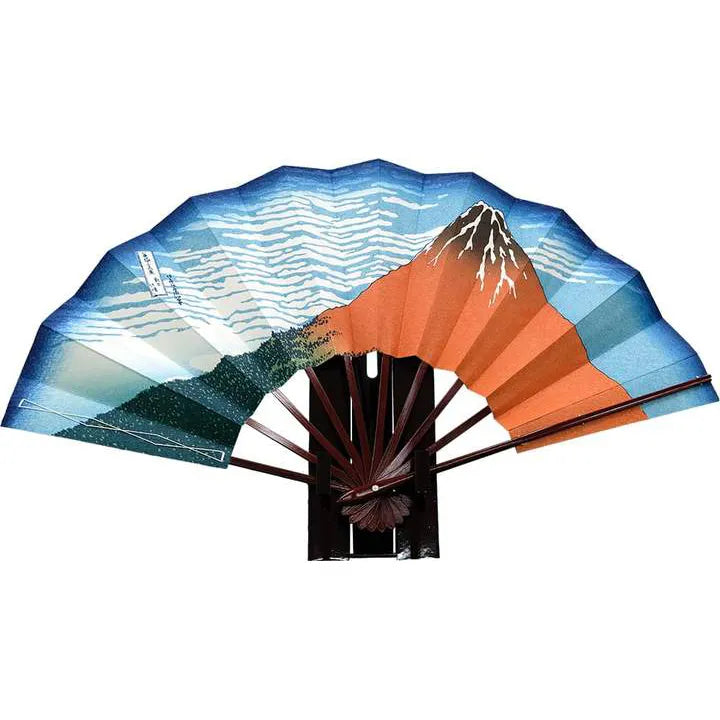
decorationfolding fan
Woodblock print decorated fan, Ukiyoe
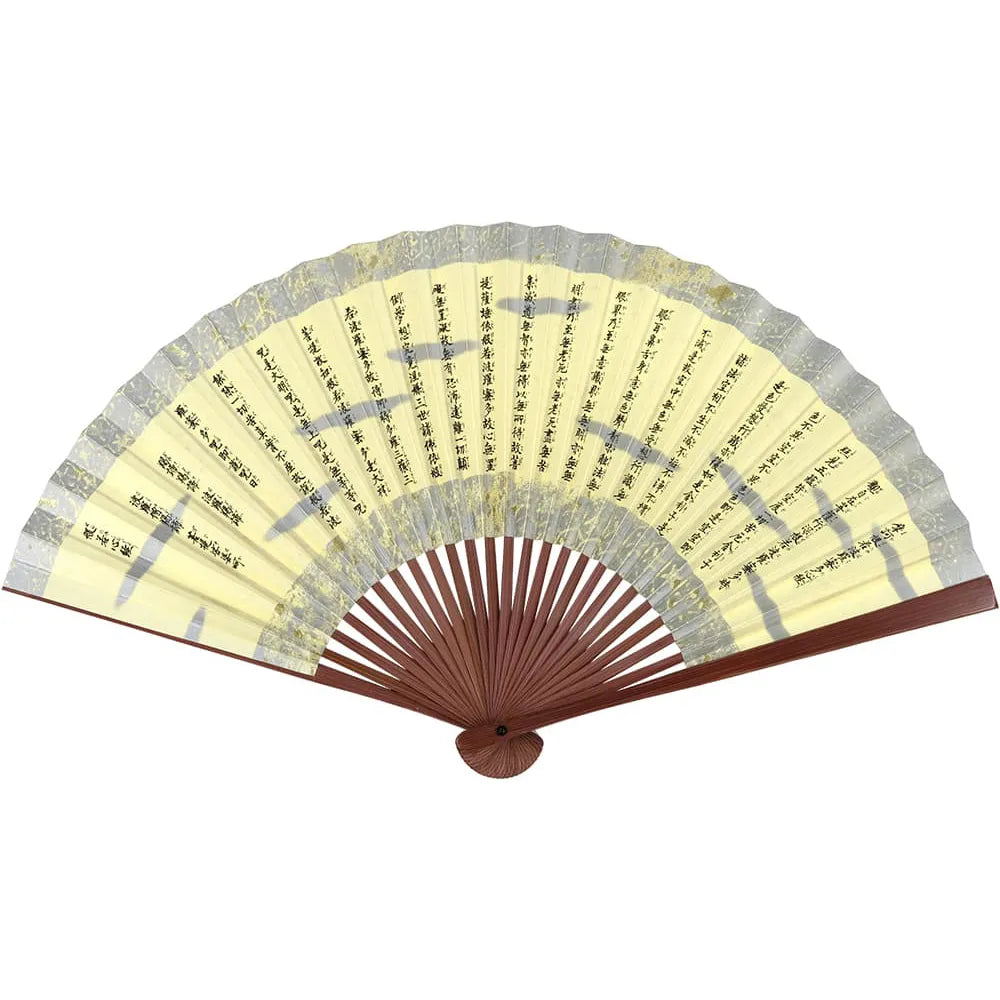
Heart Sutra
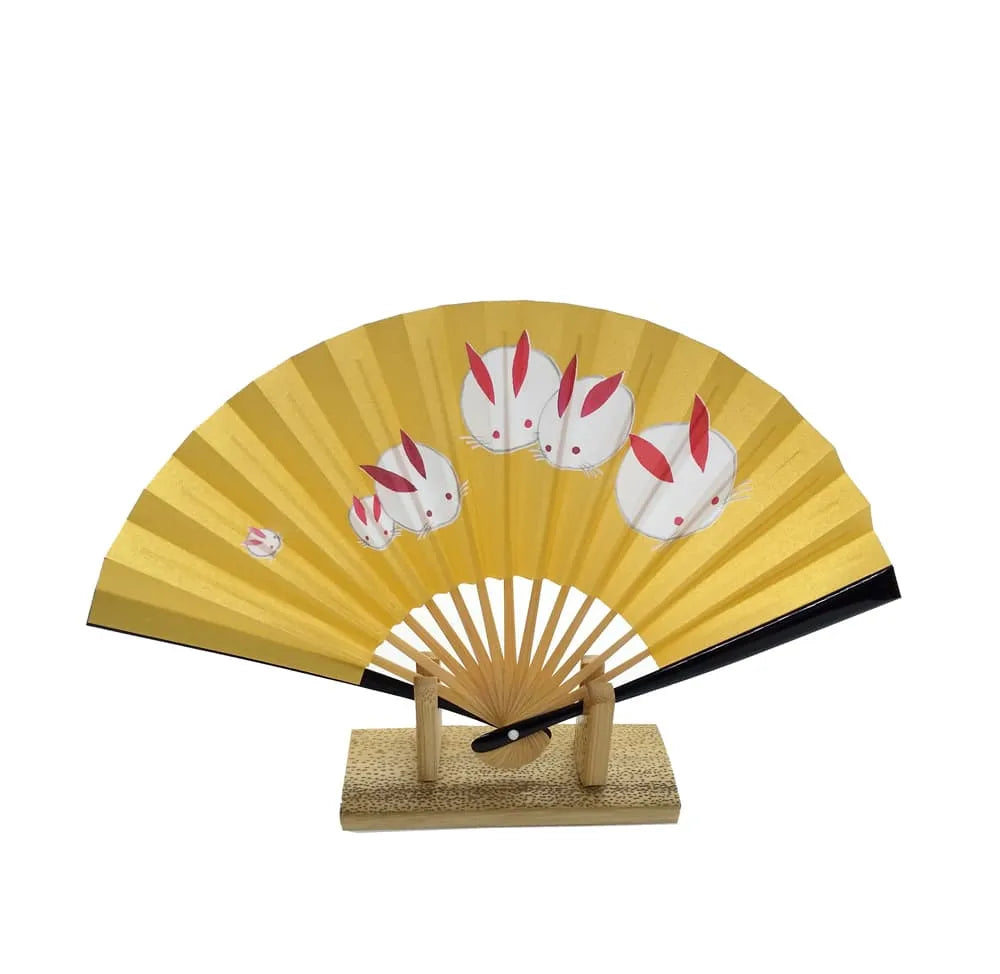
Tea Ceremony Fan
By place of origin]folding fanMain types of
In Japan,folding fanThere are a number of well-known production areas for Here is a list of the major production areas byfolding fantypes of the following.
Edo fan(Tokyo)
TokyoEdo fanwas once sold in Edofolding fanin the Edo period (1603-1867). The designs tend to be simple and bold, with small patterns and stripes, as well as animal designs and characters. To match these bold patterns, the number of bones is as few as 15, and the main bone is made thicker.
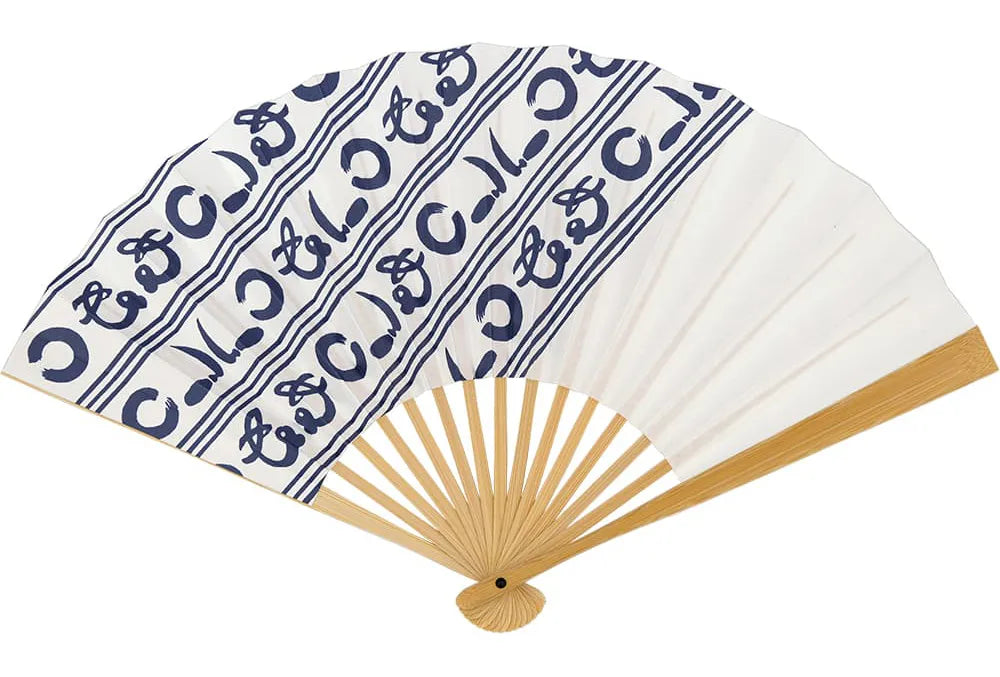
Edo fan
Hanjimono
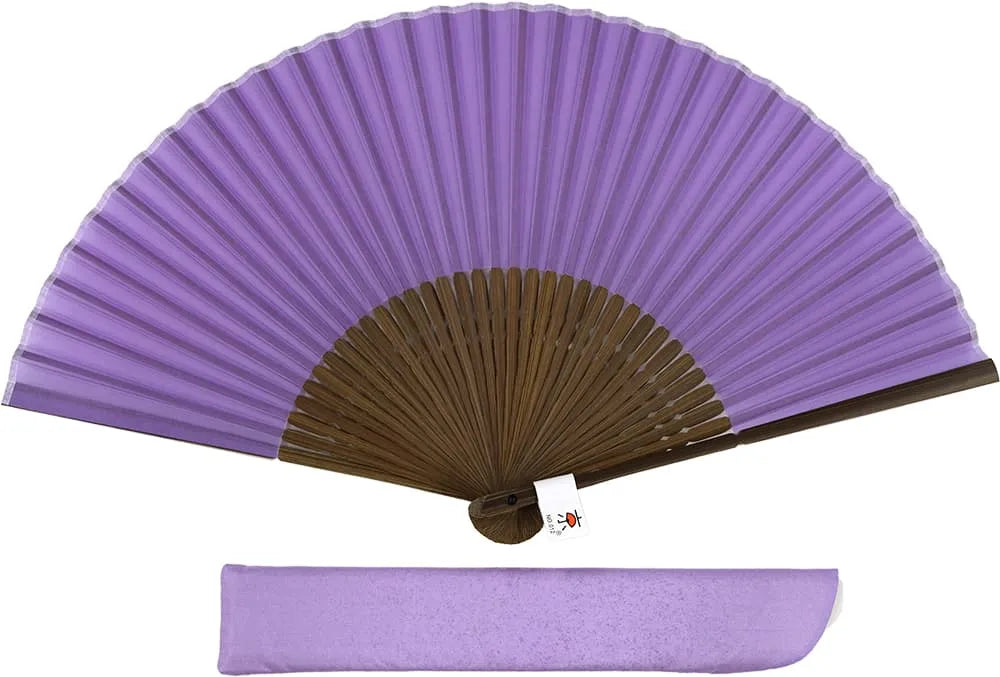
Kyotofolding fan
silkfolding fan
Kyotofolding fan(Kyoto)
Kyoto (Kyoto, Japan)folding fanis centered on the historic city of Kyoto.folding fanis the name of the city. Kyotofolding fanround fanOnly workshops and dealers that are members of the Kyoto Commerce and Industry Cooperative Association are eligible to participate in the Kyotofolding fancan use the name Kyoto. Mai mentioned above.folding fanand congratulatory fans, as well as a variety of other high-endfolding fanare produced by hand by craftsmen. [9]
Nagoyafolding fan(Aichi)
Nagoya (Aichi)folding fanis made in the production area that developed around Nagoya in Aichi Prefecture.folding fanin the area of Nagoya, Aichi Prefecture. Nagoya, along with Kyotofolding fanis known as one of the two major production centers of Of these, Nagoya is the center of men's practical goodsfolding fanare mainly produced in Nagoya. [10]
Omifolding fan(Shiga)
Omi (Shiga)folding fanis a fan made in Takashima, Shiga Prefecture, and finished with Japanese paper pasted in the local area.folding fanThe Takashima fan bone is made from high quality bamboo. Takashima fan bones are made from high-quality bamboo, and the majority of the process is done by hand by craftsmen. These fan bones are also shipped to Kyoto, where they are used in the Kyotofolding fanand are also used in Kyoto. [11]
By sizefolding fanMain types of
folding fanThere are different types of sizes offolding fanEach is different depending on thefolding fanThe length of a "K" is expressed in the traditional unit of "sun". Since one dimension is "about 3 cm",folding fanWhen the length of a closed "ma" is "about 21 cm", it is expressed as "7 sun". In addition, "ma" meansfolding fanThe "ma" indicates the number of bones of the "kiba" (the number of bones in a "kiba"). For example, when the number of bones is 15Edo fanis 7.5 sun 15 ken (about 22 cm).
Other,Shikebiki fanare 7.5 sun 35 ken (approx. 22 cm) and 6.5 sun 35 ken (approx. 19.5 cm), in different sizes. Kannishiki Shibufolding fanis 8.5 sun (approx. 25.5 cm), and Ojiya Shrinkfolding fanis 7.5" (approx. 22cm) and 6.5" (approx. 20cm), silkfolding fanis 7" (approx. 21cm), and the decorationfolding fanare 7.5" (approx. 21cm), 9.5" (approx. 28cm), and so on,folding fanPlease use this as a reference when choosing However, thefolding fanare handmade one by one by craftsmen, so the sizes are slightly different.
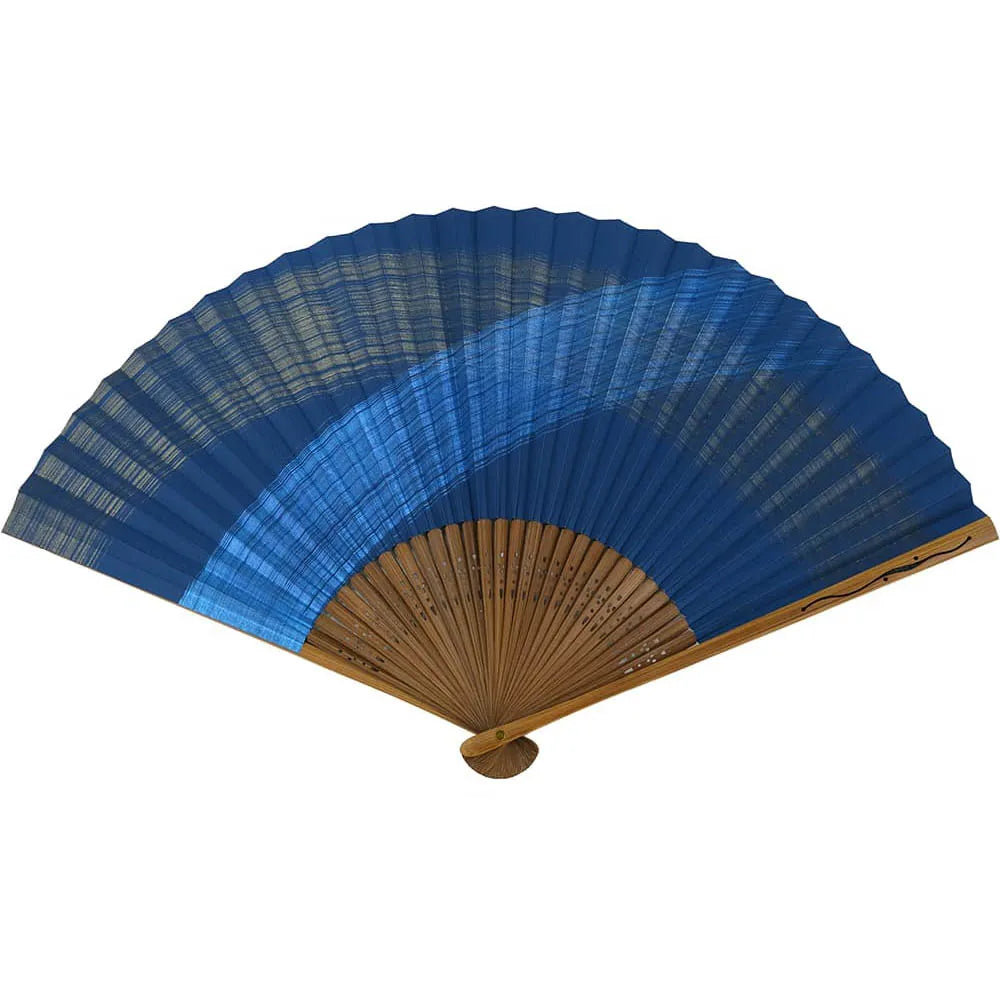
Shikebiki fan
7.5" 35 ken
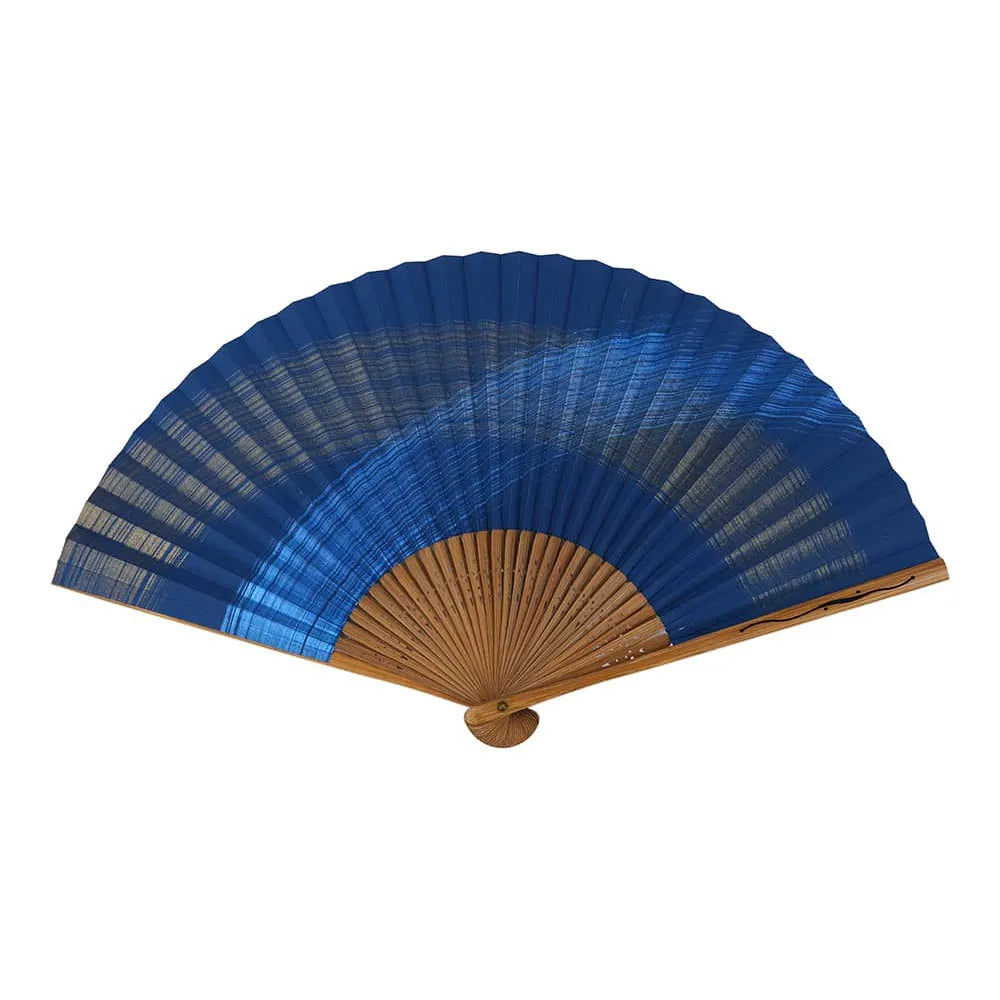
Shikebiki fan
6.5" 35 kan
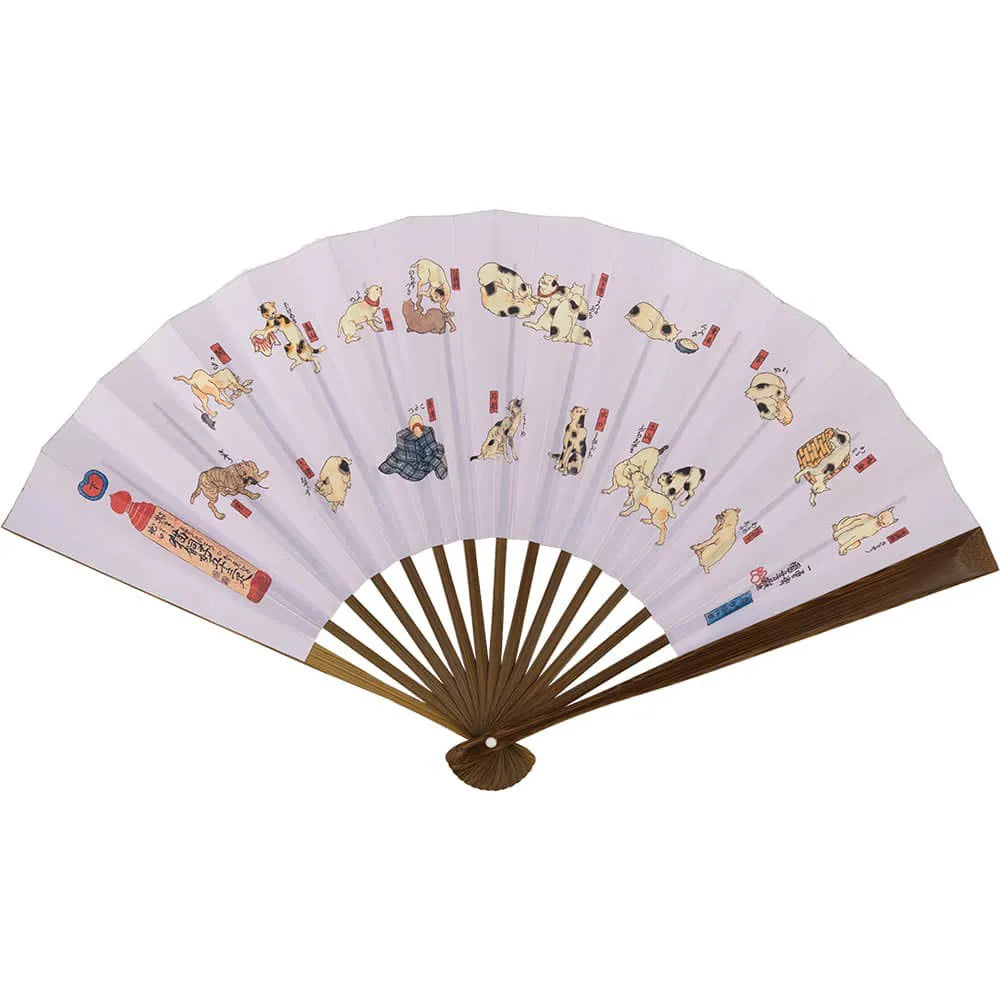
Edo fan
7.5" 15 ken
By pattern (design)folding fanMain types of
folding fanThe fan surface of a folding fan is decorated with a variety of patterns. Among the traditional patterns, there are some patterns that have a congratulatory meaning. While enjoying the fashionable designs, you can also learn from the meanings of the patterns.folding fanWhy not choose the one that best fits your needs?
gourd
The gourd is a plant characterized by its necked fruits and vines, and is known as one of the auspicious motifs for celebration. Since it bears many fruits, it has long been used as a motif of good luck. It is also said that the unique shape of the necked fruit absorbs evil spirits and keeps them at bay. Because of these characteristics, the gourd pattern is associated with such meanings as "prosperity of descendants," "prosperity in business," "many blessings," and "good health. [13]
Ayu fish
Ayu (sweetfish) is a freshwater fish found in Japan and is a familiar type of fish often enjoyed by river fishermen. In spring, young ayu fry migrate upstream, and are called "climbing ayu" as they grow. Since ayu fry climb up the river against the violent current of the water, the design of ayu fish is associated with the meaning of "success in life" and is considered a pattern of good luck. This pattern is also used in gift-giving occasions such as celebrations for employment and promotions, to wish for success in one's work. [14]
Horse
The horse, a powerful runner, has long been closely associated with human life. Many objects, including boys' kimonos and swords, are decorated with horse motifs. One of the most celebrated patterns is the one depicting nine horses running. Nine horses running (=)Umakuiku), it is used as an auspicious pattern to bring luck, such as luck in victory. The pattern of a horse facing left is also considered an auspicious pattern because the word "horse" is read upside down (=mau), which is a pun on the word "dance" (=mai), which is danced during celebratory occasions. [15]
Bamboo
Bamboo is an evergreen plant that is abundant in Japan. It often appears in Japanese folktales, including "Taketori Monogatari" (The Tale of the Bamboo-Cutter). It has long been considered a good-luck charm due to its year-round green color and the legend that the legendary Chinese bird, the phoenix, eats its fruit. Such bamboo patterns are associated with meanings such as "longevity" and "immortality. It is also used in combination with other plants as a pattern of congratulations, as in the case of "pine, bamboo, and plum. [16]
Scales
A scale pattern refers to a pattern consisting of multiple triangles arranged in a row. This is a geometric pattern that represents the scales on the body of a fish or snake. Scale patterns have long been believed to have the power to ward off evil. It has been used since ancient times, and in the Kamakura (1185-1333) and Muromachi (1333-1568) periods, it was also used as a family crest of warriors and on jinbaori (a coat of arms). There are many variations in the shape and size of the triangles, and many different designs of scale patterns exist. [17]
Dragonfly
The dragonfly is an insect known as the seasonal word for autumn, and is often used as a standard pattern in yukata. They are characterized by their large, long wings and straight forward flight. Such a dragonfly's appearance was favored by warriors because of its connotation of courage and daring and never retreating, and it came to be called a "winning insect" as a good-luck charm that brings victory. In addition, as an autumn insect that produces crops, the dragonfly's pattern also has the meaning of praying for a bountiful harvest. [18]
Seikaiha (blue ocean waves)
Seigaiha (blue ocean waves) is a geometric pattern depicting the rippling sea. It consists of multiple overlapping fan shapes arranged in a repeating sequence. This pattern has been handed down around the world since ancient times, and is believed to have been introduced in Japan during the Asuka period (710-794). The name "seigaiha" (blue ocean waves) comes from the costume used in the Gagaku (ancient Japanese court music) performance "Seigaiha" (blue ocean waves). The pattern, which represents the endless calm and wide ocean, is meant to pray for eternal peace and happiness in the future. [19]
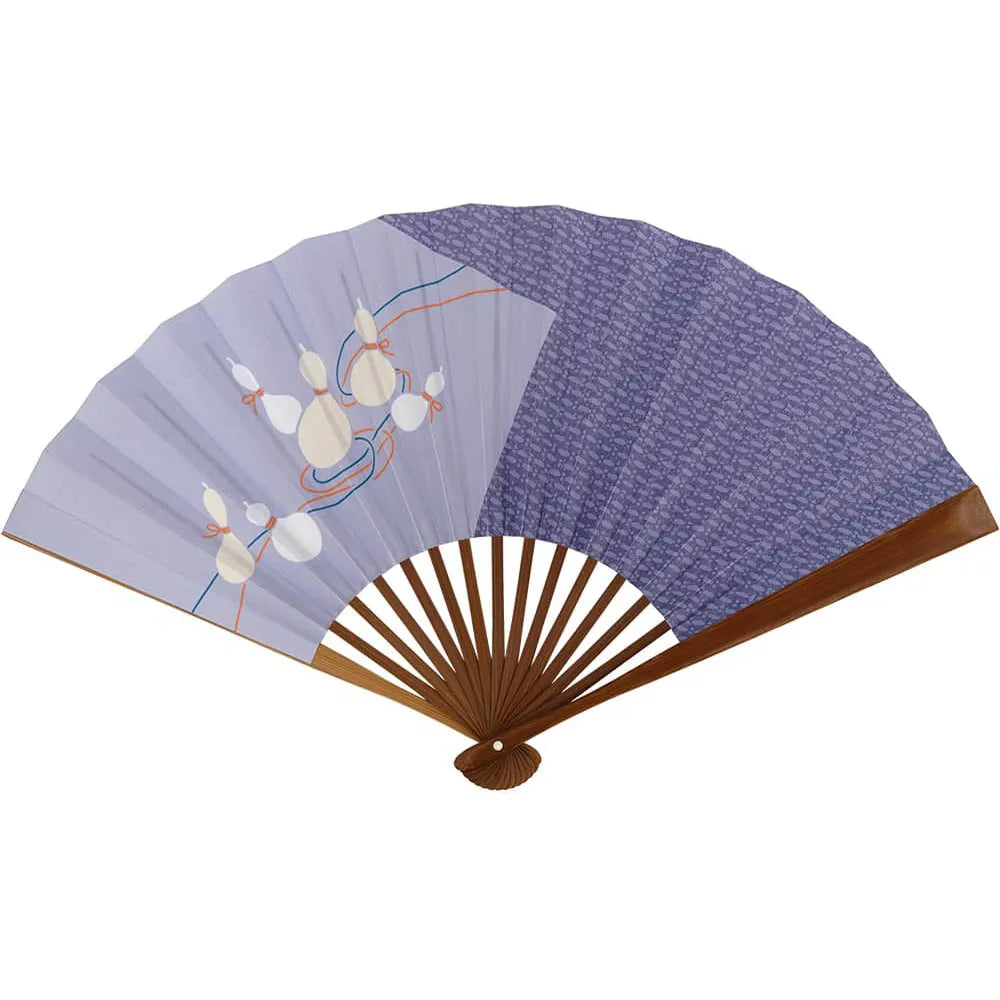
gourd
Six gourds
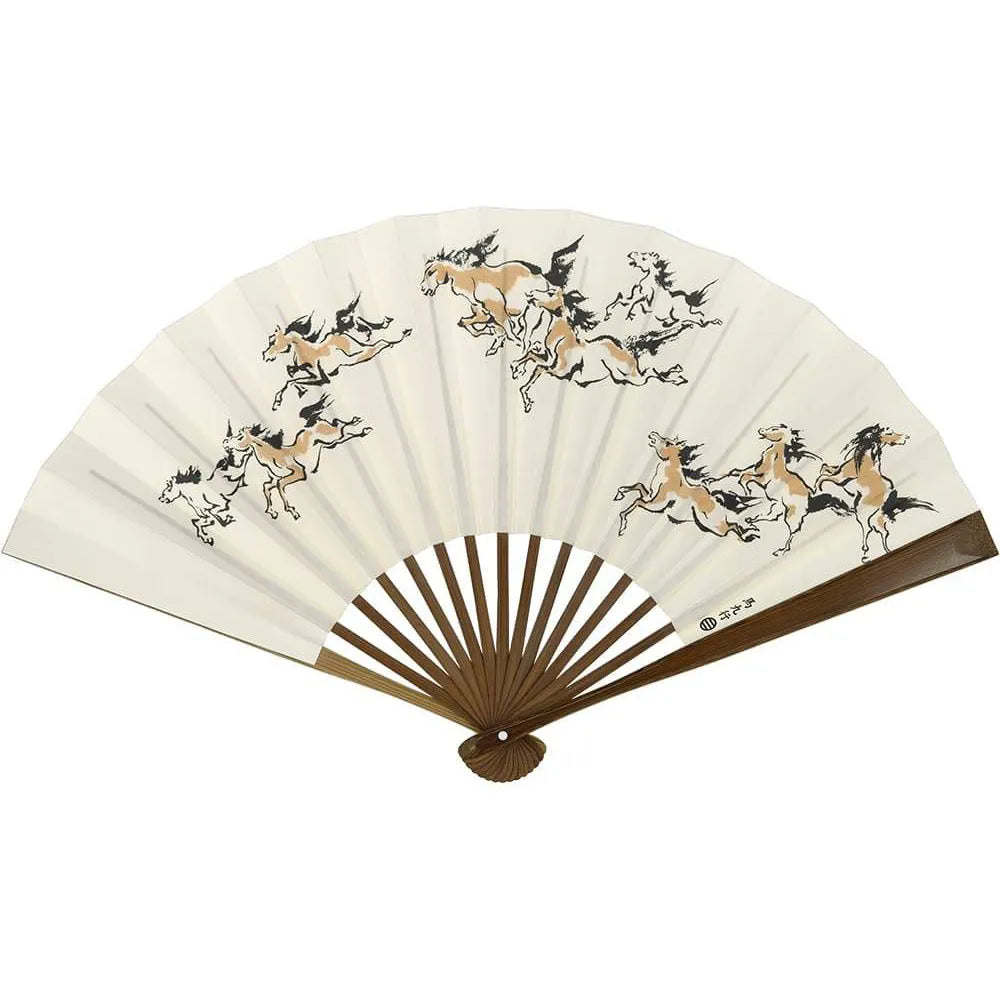
Horse
Horse nine goingUmakuiku)
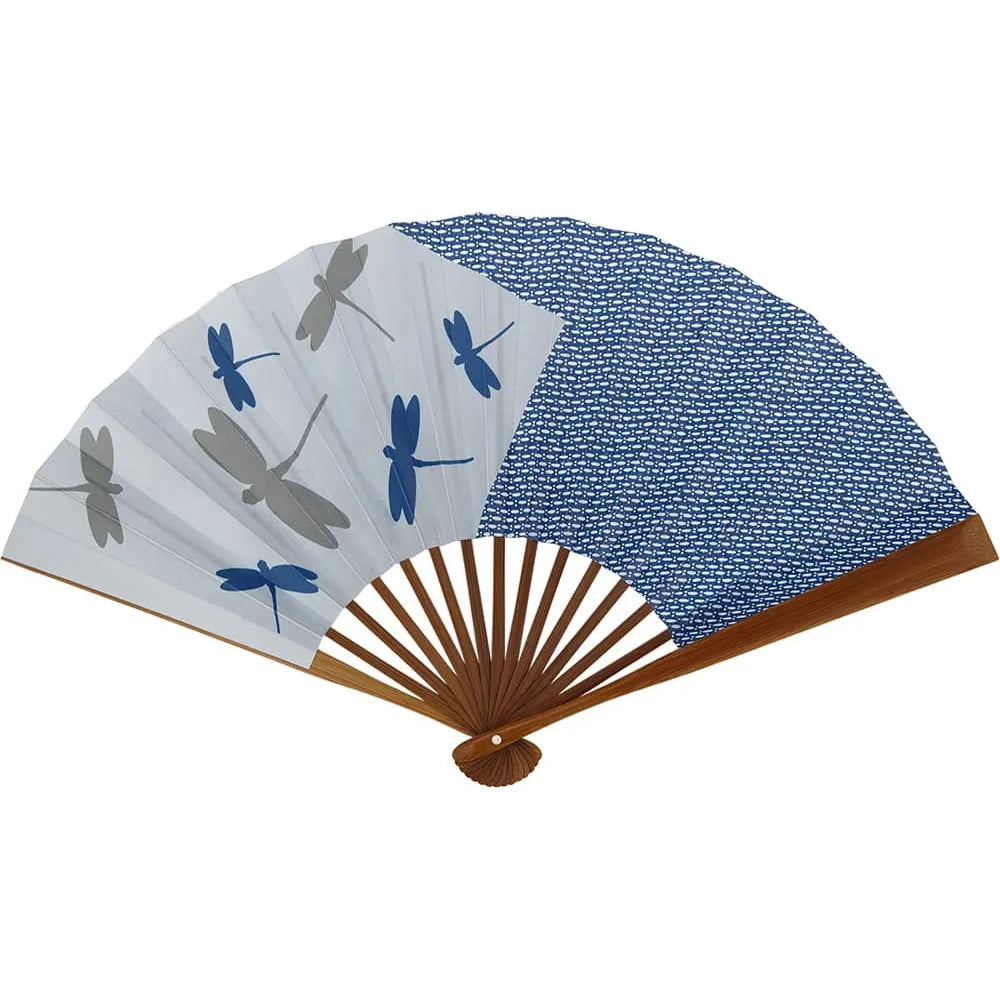
Dragonfly
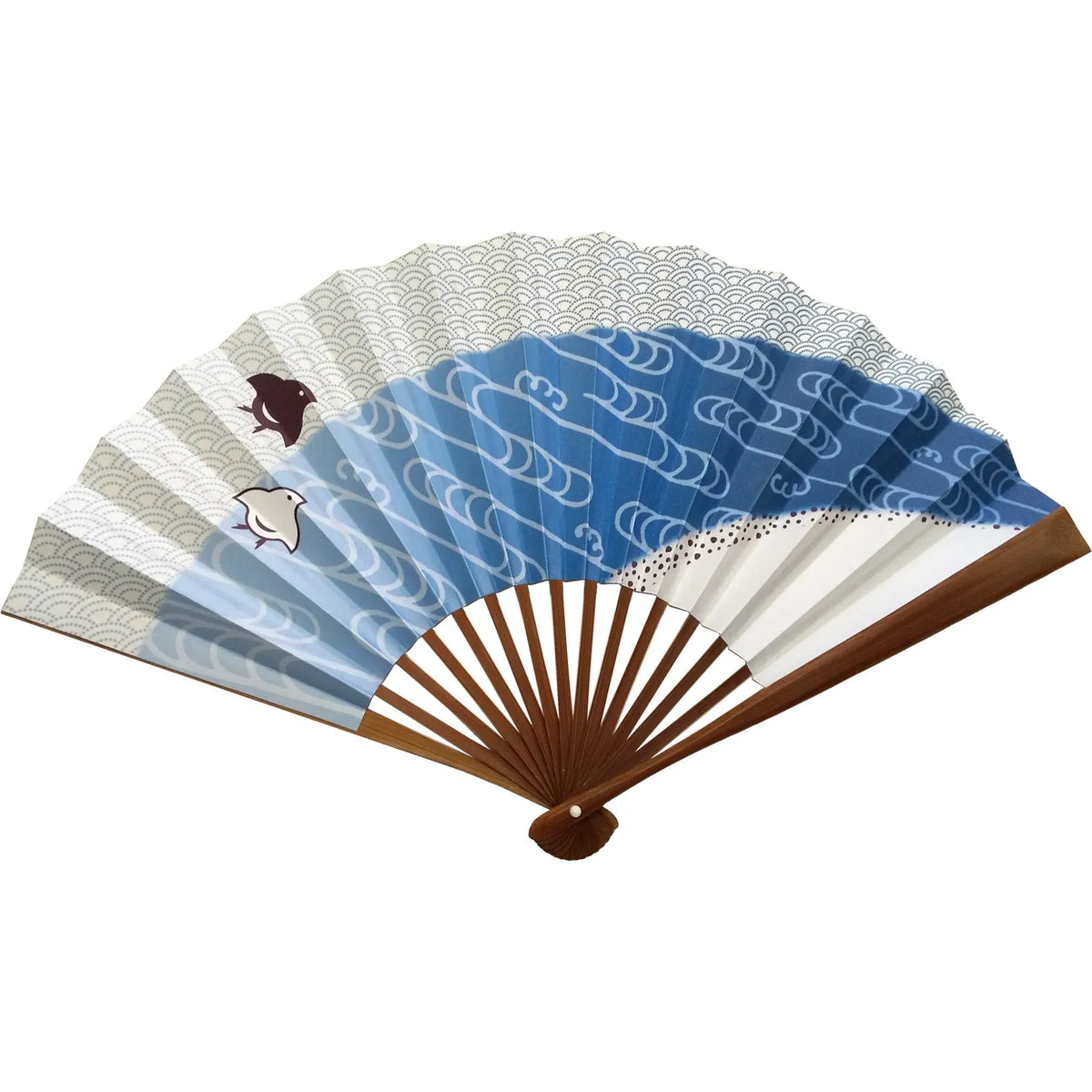
Blue sea wave and Chidori
folding fanProper use and care of
Lastly, we would like to introduce thefolding fanthe correct way to use the product. Also,folding fanwe will also tell you how to take care of yourfolding fanand to make it last as long as possible.
folding fanHow to hold your
folding fanWhen holding the "+", grip the keystone and use your thumb with the thickest thumb bone. The key is to hold it with the back of the hand facing out and pinch it between the four fingers except the thumb. When held correctly,folding fanthe hand can be made to look elegant with the charm of the hand. Not only that,folding fanand reduce the burden on your preciousfolding fanand extend the life of the precious metal. for these practical reasons as well,folding fanWe recommend that you hold the "M" in the correct way.
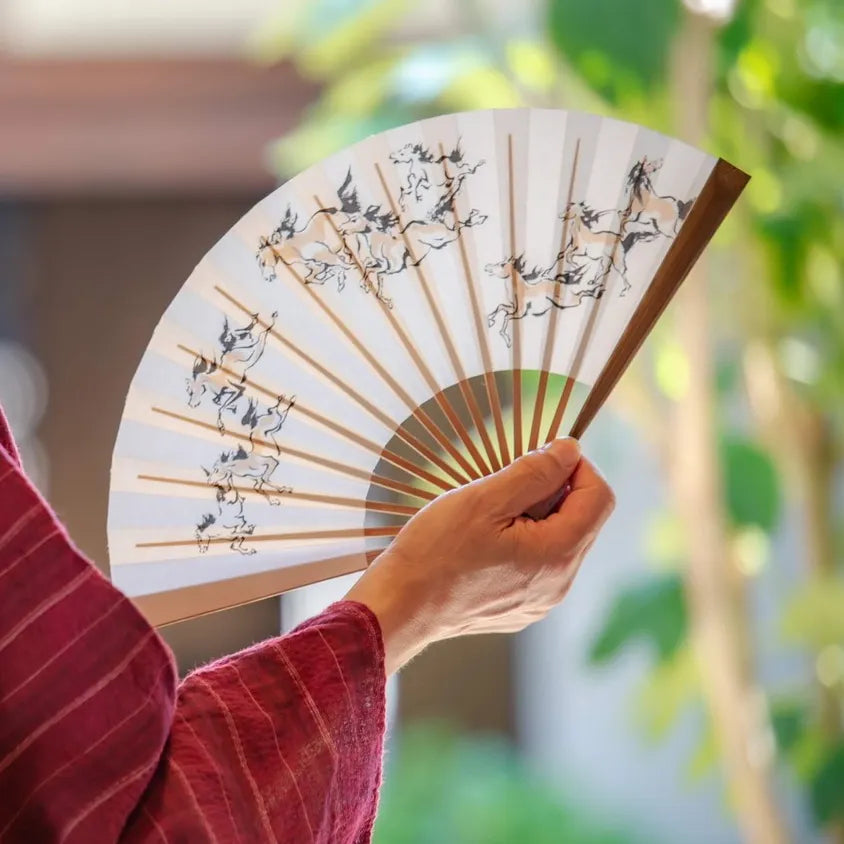
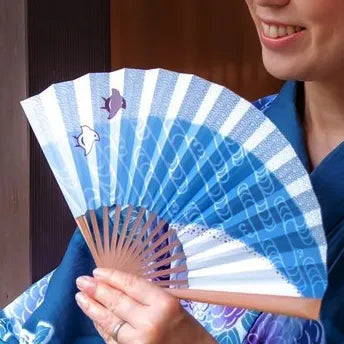
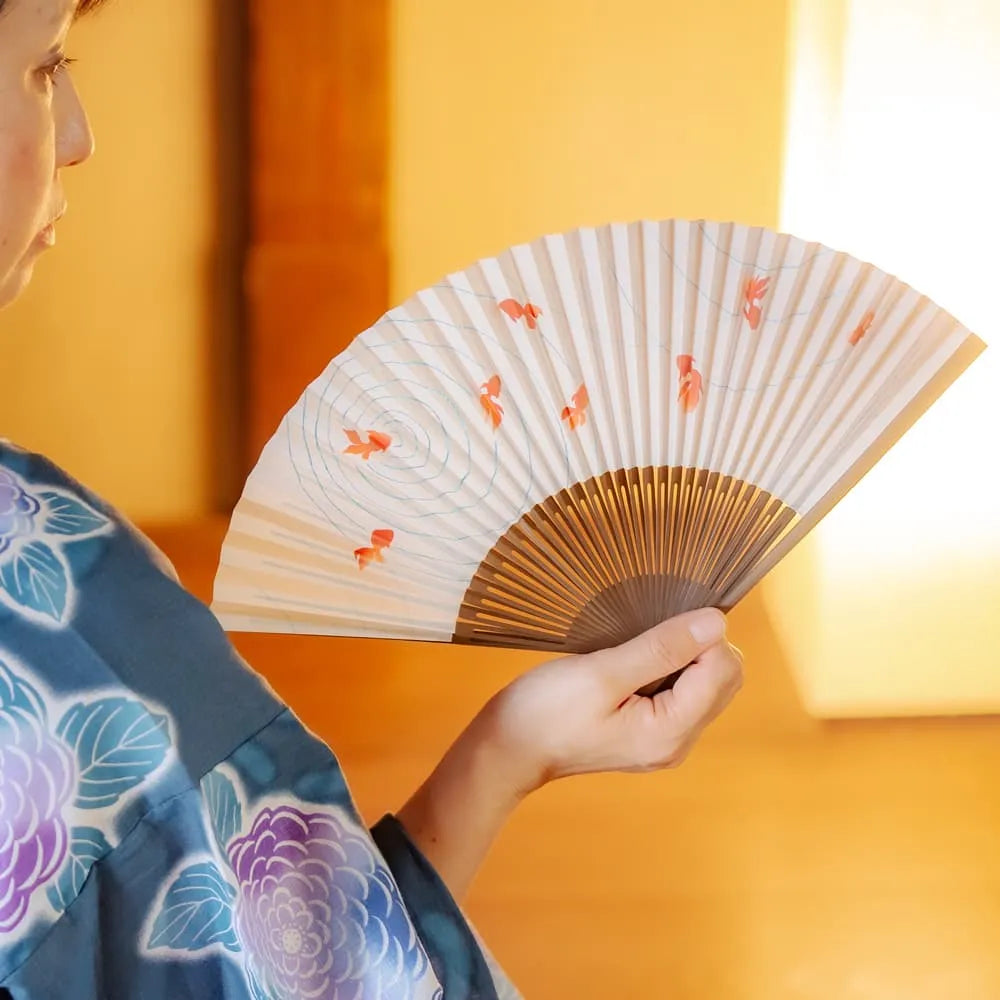
folding fanHow to open and close the
・folding fanHow to open [20].
folding fanTo open the "A", first hold it lightly with both hands, with the thumb bone facing up. Then, place your right hand on top and support it with your left hand from below. Next, place your right hand on thefolding fanThen, with your right hand on the keystone of the fan, place your left thumb on the center of the fan and push it up to the right side to spread it out. Once the fan is slightly opened in this way, slowly spread it out with both hands.folding fanIt is important to open it carefully in order to make it last longer. Also,folding fanWhen fanning with a fan, support the main bone of the fan and fan it. If you fan it with your fingers on the middle bone, it may break.
・folding fanHow to close the [21].
folding fanWhen closing the openfolding fanand carefully fold it up while pulling the middle bone one by one. Do not close it with one hand, or close it all at once with great force.folding fanThe key to making the "K" bone last longer is to close it slowly, as you do when you open it. Use both hands to handle it carefully.
folding fanHow to take care of
folding fanAfter closing the "A", secure the top part with a piece of paper or elastic to prevent it from losing its shape. In addition, you can use a piece of paper or elastic to secure the top of the bag after closing thefolding fanWhen carryingfolding fanbag for safety. Note that the fan surface is particularly delicate and may be damaged if placed in a bag as it is.folding fanare susceptible to water, regardless of the type, so if they get wet, wipe them dry immediately and dry them thoroughly.
In addition,folding fanThe key parts of the "*" are parts that are prone to wear out during use. If it should break, we recommend that you consider repairing or refurbishing the keystone. Please take care of the daily care of your preciousfolding fanto last for a long time.
folding fanNotes on the use of
Take care not to let the wind blow on people around you [22].
In places where there are other people nearby, such as inside a train or bus, in an elevator, or in a theater seat.folding fanBe sure to be considerate of those around you when using a In public places,folding fanSome people do not like to be exposed to the wind from a fan or to the sound of a fan being blown nearby.folding fanIn addition to determining when it is appropriate to use a gracefulfolding fanBe sure to use appropriate manners and gestures for the
Avoid flapping and moving quickly [23].
folding fanWhen fanning yourself with a fan, it is better to move slowly to make your gesture look more beautiful. On the other hand, if you make large, flapping movements with thefolding fanOn the other hand, avoid large, flapping movements. Not only do small, quick movements give the impression of being too busy, but many people are bothered by them when they are in view. In public places, fanning yourself strongly can easily cause the wind to blow against those nearby,folding fanSo, pay attention to the way you fan yourself in public.
When enjoying fragrance, be careful not to put on too much and consider TPO [24].
folding fanSome products made from sandalwood and other aromatic woods are available for fragrance enjoyment. Also, if you are using your perfume in afolding fanto enjoy the fragrance each time you fan yourself is one way to do this. However, the fragrance may be disturbing when you are in a public place or enjoying a meal. In this wayfolding fanBe careful not to apply too much fragrance and consider TPO when enjoying fragrance withfolding fanUse of fragrances in the following manner is recommended.
Cautions for weddings [25].
Inserted on the left breast of the obi of a black or colored tomesode kimono during celebratory occasions such as weddings.folding fanis called suehiro. Suehiro" means spreading from the top to the bottom (the end), and is shaped like the numeral "8. The word "suehiro" means "spreading out," and has long been associated with development and prosperity, making it a very auspicious symbol.
However, there are some manners that must be observed when using suehiro. It is taboo to open a fan and fan out. The original purpose of the suehiro is ceremonial, to create a boundary between you and your partner. In other words, to create a boundary between the other person and oneself implies "to be courteous to the other person. Therefore, to express gratitude to the other person, please be careful not to use it in a way that goes against the original use of suehiro, as it is a breach of etiquette.
Check the type before purchase and use the appropriatefolding fanbefore you buy!
This is as far as we have gone,folding fanby material, purpose, production area, size, and pattern (design).folding fanare popular items not only for your own use but also for gift-giving occasions such as celebrations. You can choose from a large number of types, and depending on the purpose of purchase, you can select the appropriatefolding fanPlease select the one that best fits your needs. Also,folding fanwill not only make your gestures look beautiful when used correctly, but also provide you with importantfolding fanand also prolongs the life of your preciousfolding fanIt is also important to consider the manner in which you use the "K" in some situations. Please refer to the information we have given you and use it widely in your daily life.folding fanWe hope that you will find the information provided useful in your daily life.
